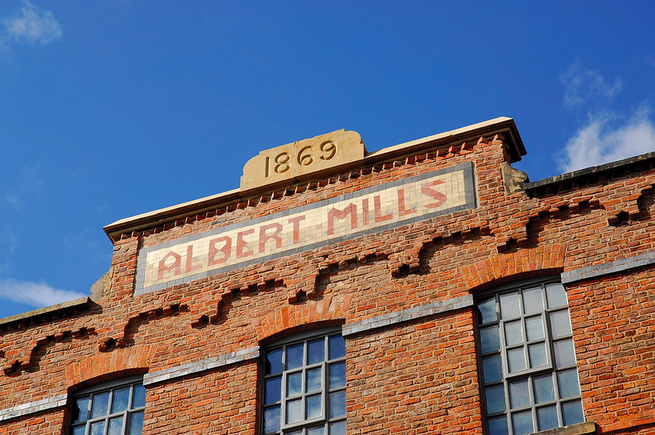Manchester as a Case Study in Gentrification-Weaponized Art
by Xan Holbrook
As anyone who has read my work can intuit, I am an Englishman. Specifically, from Manchester.
The story of Manchester is one of change. Ask anyone who sells apartments or business space around here and they’d trot out “rebirth” or “reinvention” but the point remains true. A rainy space in the North of England with no real cultivable or arable land around it, just flanked by low-lying moorland and hills on three sides. An industrial and manufacturing centre, known as King Cotton, or Cottonopolis. At its peak, it processed a quarter of the world’s textile supplies. Birthplace of modern computing, railways, the football league, the split atom, and the bouncing bomb.

All of this is very well, and could easily fit in any guide book about the city. What is not seen are the rivers of African and Indian blood which that cotton spilt. The slums and mass graves of Angel Meadow, where cholera and typhus reigned with impunity over the migrant working class. Alan Turing, chemically castrated after performing an invaluable service to the British war effort, turning to cyanide. The years of drudgery, degradation, unemployment and squalor as the industry declined. Despite a free, Rolls-Royce service with the NHS, the city has the fourth highest infant mortality rate in the country. Mills that dotted the skyline, and provided jobs for thousands, now sitting empty.
If only something could be done with them…

Manchester’s cultural seam exploded in the 1980s. The legendary Factory Records brought Joy Division, New Order and The Happy Mondays to the world’s attention, as well as reinventing art and graphic design for a generation in the process (and this is to say nothing of the seminal Hacienda superclub, with its cavalcade of bands and DJs). Fellow Mancunian bands The Stone Roses, Primal Scream and The Smiths also conquered the charts, making way for bands like Oasis, Doves and Elbow to follow through the 90s and beyond.
Notwithstanding all this, it remained a forbidding place to live. The gang wars of Moss Side and Cheetham Hill, fueled by the ecstasy boom, introduced tit-for-tat gun murders to the streets, leading to the grim moniker of Gunchester in the press.
This would all change from one moment.
On 15 June 1996, the IRA detonated the largest peacetime bomb Britain has seen, a 1500kg lorry bomb, on Corporation Street. Although very lucky to have had no deaths, the city centre was flattened. It was here that the reputation for redevelopment began.
New Labour, or a new centre-left in British Politics, was on the move and, although not in power in London, they controlled Manchester’s city council. The demolition of old, bomb-damaged property began, but so did the development. At first, this was a step in the right direction for the city. Many of the buildings in neighborhoods like Ancoats, Oldham Street, Piccadilly and Collyhurst were derelict shells. The arrival of such companies as Urban Splash heralded a move away from the dark times.

From the off, the creative agencies around Manchester tapped into its radical politics and unique cultural history. One of the Millenium projects, a museum/art space called Urbis, had George Orwell’s take on the city – “the belly and the guts of the nation” – written on its windows, along with Morrissey’s much grimmer “Manchester – so much to answer for” (a reference to the casual brutality which led to the gestation of Ian Brady and Myra Hindley). The hazard colours – yellow and black stripes, found on electrical tape – were, and are, ubiquitous. Tony Wilson’s words are everywhere, from graffiti to motivational quotes in corporate offices. Peter Saville’s trailblazing graphic design is everywhere (duh), to the point of complete ridiculousness. So far, so standard gentrification – there isn’t a post-industrial city on Earth that doesn’t have stories like these.
Where the title of this article comes from is my own observation of the tactic of art-washing. Again, this revelation is not new to me. Developer’s tactics – shadow-funding art projects, or flat out inviting arty people to squat in buildings destined for redevelopment, in order to make an area more attractive – turn the bohemian ideal of ascetic living into a perverse form of social cleansing. The way in which this is amplified for Manchester is not because of my familiarity with and love of the town, but because of how this was achieved was bound up with so much of Manchester’s past.

The area of Ancoats used to be a Mill district. It was a place I used to rehearse in when I was in bands, and wasn’t a place one would like to be caught walking around at night, even less so when carrying a bass guitar. Its mills were turned into the standard brown-space luxury loft flats, but sales slowed.
While people couldn’t afford the extortionate rent on the flats, there was another option. The Manchester Ship Canal’s commercial days were long behind it, but the leisure barges still cruise it most days. Urban Splash, in cahoots with the council, invited people to live on the canal boats. As mooring fees were drastically cheaper than paying rent and council tax, and the location was central to the city, the choice was obvious for many of the artists and downtrodden. The area became known as an arts’ district. The area around Oldham Street and Stevenson Square, rebranded as the famous Northern Quarter, was still a hub for creatives, and the Ancoats boats were close enough that many musicians, designers and more could live within walking distance and use their meagre pay to subsist themselves.
The flats sold very quickly after this, and demand soared to the point where houses are being built along the edge of the canal on former wasteland.
And the boats?
Now that the area had been successfully redeveloped, the mooring fees skyrocketed, and people had to either move down the canal or give up on boats entirely.
Be wary of any place that claims to be the hot new place to be, or to have a vibrant arts scene. It may only stay that way until enough units shift that the sinister fuckers behind it go somewhere else and turn a town’s culture against itself.









